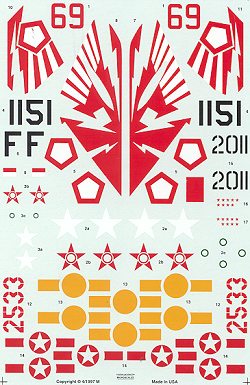
|
Sheet: |
Aeromaster 48-324: Mig-17F |
| Units: | Various |
|
Price |
$ |
|
Reviewer: |

Without a doubt, the most important Soviet-designed aircraft of the 1950s was the Mig-17. It had all the proper Russian attributes. It was a simple plane that could be maintained by semi-qualified personnel. It also had a strong airframe and a reliable engine. Firepower was strong with three large calibre, but slow firing cannon, and the airframe was robust and maneuverable. You can ask any US pilot who tangled with them in Vietnam that they just couldn't do a standard dog-fight with a Mig. It would have been suicide.
When it comes to kits in 1/48, you have two to choose from. One is the Hobbycraft/War Eagle version. It is an early Hobbycraft release so is often shunned as it has a few shape concerns that most of us wouldn't recognize. The other is the SMER kit that was also marketed by Aeromaster with a ton of resin bits and a nice decal sheet. Anyone want to bet which kit this sheet was designed to fit? If you guess the SMER/Aeromaster one, you win a lolly.
Of the four options, the first one, for Bulgaria, is the only
one that is in camo. It has an interesting disruptive scheme of tan and dark
green over a light blue-grey lower surface.

Next is an Indonesian plane that may have been with an aerobatic team. It is this scheme where any kit differences would be noticeable as the tail and wing markings are specifically for the SMER kit.
Next is the first of two North Vietnamese planes. Actually, I guess that would just be regular old Vietnamese now since they did triumph in that conflict. The first plane is one that was flown by 923 sq and is on display at a Hanoi museum. It carries 9 kill markings, the same number achieved by their top ace of the war, Nguyen Van Coc. However, aircraft were often decorated with the number of kills achieved by that plane and not by a specific pilot.
The other plane is one with a red fin tip. In all regards, these planes would have been heavily weathered and quite dull looking in actual service. Southeast Asia has a climate that is not conducive to pristine-looking aircraft, especially under wartime conditions. I daresay that any painted on items like insignia and tactical numbers would also have been a bit chipped and worn as well.
If you would like your product reviewed fairly and quickly by a site that has well over 175,000 visitors a month, please contact me or see other details in the Note to Contributors.